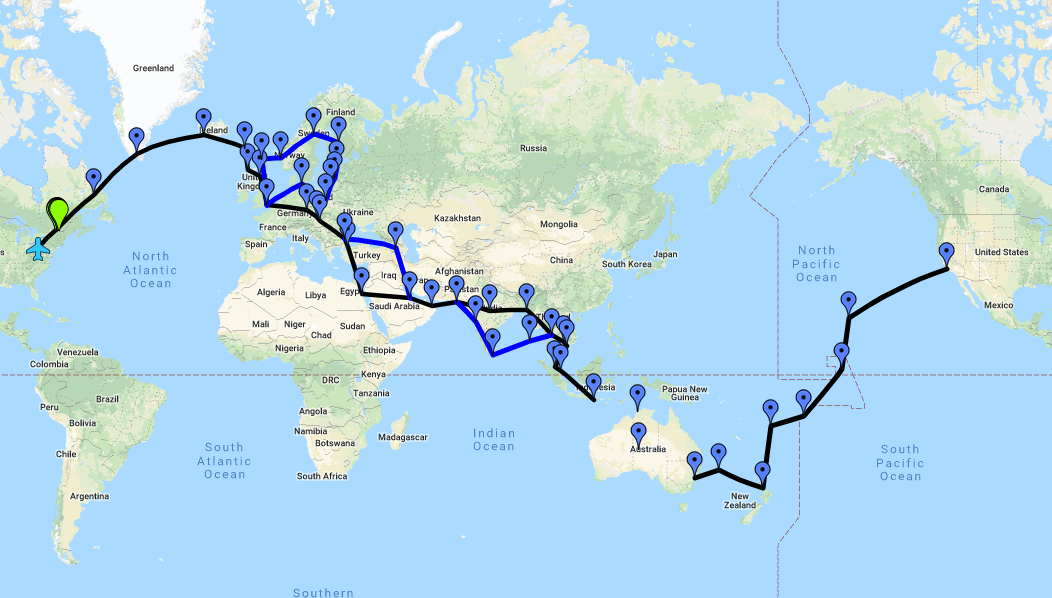Katamarino
Pattern Altitude
Edit: important first point. If anyone else wants to get involved; fly along for sections, bring their own airplane along for bits (Atlantic crossing for example), or have involvement in any other way; let me know! Always more fun to work with others on stuff like this.
As alluded to my in Alaska/Canada thread, the next big adventure is planned as an around-the-world, from roughly May 2019 to January 2020. Flying about 3.5 weeks at a time. I'm starting this thread to solicit ideas and guidance from others who have done similar travels, as well as anyone who wishes to offer advice, abuse, or flippant comments.
Current planning status
Aircraft status and prep:
I have emailed my insurance broker to start looking into that. He hasn't replied...so I may be looking for a new one!
Maintenance en route:
I'll probably be doing about 3-400 hours along the way. I'm planning to aim for an oil change, using Aeroshell W100+, at the end of each flight period before I leave the airplane so while it sits it has fresh oil in it. Will need to come up with a plan for an annual at some point along the route, most likely in NZ. Might have to get a passport for my A&P! Spark plugs will need to be gapped and cleaned a few times. I am planning to put all new plugs in before departure, my current ones have a few hundred hours on.
Spares: I plan to take a tube for nose and main, and a couple of spare spark plugs. I can get most anything sent out if needed, and want to keep weight minimal. Anything else? I'll take a few simple tools, enough to do oil change and spark plugs.
Route:
Still pretty much "under development". Current thoughts here:

Here's a link to the map, with notes etc under each stop and a couple of alternative options.
https://drive.google.com/open?id=11w3UJeK8XLZmjBqhdeRBSaa3IIs&usp=sharing
Biggest challenge right now seems to be sourcing AVGAS in Kiribati. If anyone has any contacts or ideas..?
Rough plan timing-wise is as follows, 3.5 week flight period by flight period:
Training and equipment:
I plan to do a ditching course before I go. In terms of equipment:
As alluded to my in Alaska/Canada thread, the next big adventure is planned as an around-the-world, from roughly May 2019 to January 2020. Flying about 3.5 weeks at a time. I'm starting this thread to solicit ideas and guidance from others who have done similar travels, as well as anyone who wishes to offer advice, abuse, or flippant comments.
Current planning status
Aircraft status and prep:
- C182R model
- Low time (400 hours) PPonk engine
- 111 gallons total on board (mains and added tip tanks)
- Dual G5s, vacuum system removed (G5 HSI still to be fitted)
- GTX345 (still to be fitted)
- STEC-30 with Alt hold
- GNS430W
- Aera 660 in panel mount
- JPI-830 engine monitor
- 3 x USB charging ports in panel (including one from PMA450B audio panel)
I have emailed my insurance broker to start looking into that. He hasn't replied...so I may be looking for a new one!
Maintenance en route:
I'll probably be doing about 3-400 hours along the way. I'm planning to aim for an oil change, using Aeroshell W100+, at the end of each flight period before I leave the airplane so while it sits it has fresh oil in it. Will need to come up with a plan for an annual at some point along the route, most likely in NZ. Might have to get a passport for my A&P! Spark plugs will need to be gapped and cleaned a few times. I am planning to put all new plugs in before departure, my current ones have a few hundred hours on.
Spares: I plan to take a tube for nose and main, and a couple of spare spark plugs. I can get most anything sent out if needed, and want to keep weight minimal. Anything else? I'll take a few simple tools, enough to do oil change and spark plugs.
Route:
Still pretty much "under development". Current thoughts here:

Here's a link to the map, with notes etc under each stop and a couple of alternative options.
https://drive.google.com/open?id=11w3UJeK8XLZmjBqhdeRBSaa3IIs&usp=sharing
Biggest challenge right now seems to be sourcing AVGAS in Kiribati. If anyone has any contacts or ideas..?
Rough plan timing-wise is as follows, 3.5 week flight period by flight period:
- Atlantic crossing US to UK (the aircraft's new base)
- UK to Thailand
- Thailand to Australia
- Pacific crossing back to USA, and on to UK to complete the circle.
Training and equipment:
I plan to do a ditching course before I go. In terms of equipment:
- Quality 4-6 person life raft including equipment package (flares etc etc)
- 2 good quality life jackets; mine has gear pockets for things like PLB.
- Survival knife with seat-belt cutter.
- Small dry bag to pack with some food and water and anything else I might want in event of ditching, kept within reach of pilot seat.
- Dry-suit for Atlantic crossing section (not planning on it for Pacific..)
- Garmin InReach for tracking and in-flight communication
- Tablet with Garmin Pilot
- Land survival pack for the more remote overland sections, to be shipped back to USA before the Pacific legs.
Last edited:
